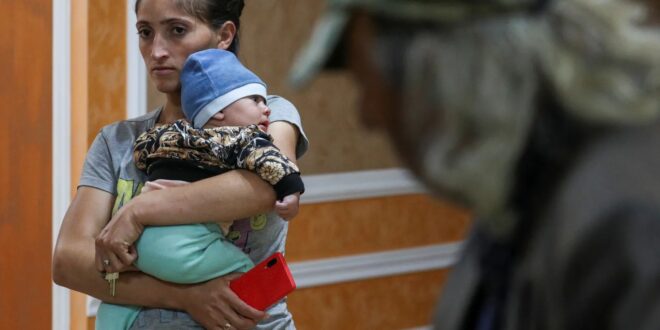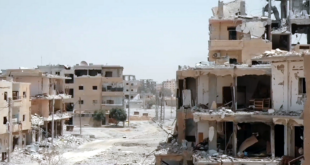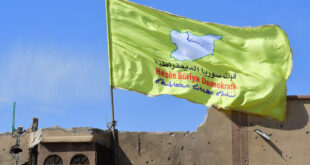How Western Inaction Enabled Azerbaijan and Russia
The third war over Nagorno-Karabakh, the long-disputed Armenian enclave within Azerbaijan, ended almost as soon as it began. At 1 PM on September 19, Azerbaijani forces began attacking the territory with artillery and drones in what it called an “antiterror” operation. Within 24 hours, the Karabakh Armenians, a population that has been pushed to the brink of famine by a months-long economic blockade, capitulated, leaving Azerbaijan in effective control of the territory.
The next phase of the tragedy is now unfolding. In scenes reminiscent of the Balkans in the 1990s, convoys of cars are filling the mountain road from Karabakh to Armenia carrying thousands of Karabakhis leaving their homeland with as much as they can carry. Many or most of this isolated population seem likely to join them in the coming days and weeks, in what could amount to yet another round of de facto ethnic cleansing in a region that has witnessed many such upheavals over the years.
There is a bigger long-term failure here, that of successive Western governments to prevent the violence in the first place and get Armenians and Azerbaijanis to agree an equitable resolution to this bitterly contested conflict.
For the local population—after 35 years of euphoria, siege, victory, defeat, and many fateful miscalculations by their leaders—this outcome is a bitter end. It marks the complete destruction of a project that began in 1988 when the Armenians of Karabakh first tried to split away from Soviet Azerbaijan. And it goes back further than that: the loss of this territory with centuries-old Armenian history and heritage will be felt by Armenians for years.
The Azerbaijani government in Baku is celebrating. It has already called for the dissolution of all political structures in the territory—the local presidency, parliament, and elected mayor—and is not offering the kind of political autonomy, that other European minorities have received in analogous situations. Instead, Azerbaijani President Ilham Aliyev reminded the Karabakh Armenians that an earlier offer of status had “gone to hell” and what was left on the table were as yet undefined “educational rights, cultural rights, religious rights, and municipal electoral rights.”
Under those terms, some older people might choose to stay in Nagorno-Karabakh, and thousands of Azerbaijanis who lived there up until 1991 might return. But little or nothing will remain of all the local institutions built there over three decades.
This brutal outcome will also be a stark commentary on the role played by the region’s would-be overlord, Russia. Although the enclave had in theory been under the protection of Russian peacekeepers, Moscow’s guarantees ended up being worthless. Russia has instead brokered a deal whereby the local population agreed to a full disarmament of their own “defense forces,” numbering several thousand men, and to begin talks over their full “reintegration” into Azerbaijan.
In the end, Moscow’s position was crucial. Moscow did not start the Armenian-Azerbaijani conflict in 1988, but for the fourth time (if we also include a brief bout of fighting in 2016), it has intervened to broker a cease-fire in which it exacts a price and furthers its agenda. This time, the price may be that Russia gets to keep its peacekeeping force on the ground and thereby a foothold in Azerbaijan; and to push Western mediators—the European Union and United States—further to the margins.
MY LAND, NOT YOUR LAND
Violence, not diplomacy, has always determined key outcomes in the dispute over Nagorno-Karabakh. This has a lot to do with mutually exclusive ethnonationalist projects in Armenia and Azerbaijan, neither of which could accept an unstable arrangement dating back to the beginning of the Communist era. In 1921, the Bolsheviks gave the Armenian-majority province autonomous status within Soviet Azerbaijan.
After the collapse of the Soviet Union in 1991, internationally sponsored negotiations tried to balance Azerbaijan’s territorial integrity—its viability as a state—with the aspirations of the Karabakh Armenians. But what was on the table also reflected the outcome of the use force on the ground: more generous offers to the Armenians up until 2020, when they were in a dominant position, and a tilt toward Azerbaijan after it prevailed in the conflict that year.
In 2022, having effectively lost control of Nagorno-Karabakh, Armenian Prime Minister Nikol Pashinyan started saying publicly that Armenia renounced its territorial claims on the region. Instead, the formula he adopted in talks with Azerbaijan facilitated by the European Union was that the issue was now “the rights and security” of the Karabakh Armenians. In turn, Aliyev ever more frequently employed the term “territorial integrity” as if it provided carte blanche for a government to do what it wants with any community under its control—and used the war in Ukraine as cover for this. Western officials told him that the territory would return to Azerbaijani jurisdiction but that patience was needed. As recently as mid-September, he received calls from U.S. and other Western officials warning him against resorting to military force. Yet he decided once again to do so.
Russian acquiescence was crucial to Azerbaijan’s blockade of the region.
There is a domestic logic to Aliyev’s actions. For two decades, he has been the leader of an authoritarian state in which there are no democratically elected local officials and minorities enjoy few formal protections. Why should he agree to Western demands for a model of conflict resolution that compels him to offer autonomy to a national minority community and weakens his hold on power?
Moreover, Aliyev evidently believes that Turkey and Russia, not Western countries, are the only powers he needs to take seriously. Although Turkey and Russia do not agree on much, both see the utility of limiting Western engagement in the South Caucasus, a region where they have traditionally wielded influence. Turkey, Aliyev understood, would support his effort to take full control of Nagorno-Karabakh, Russia would not prevent it, and the West, with very little leverage in the region, would be unable to prevent him from changing the facts on the ground.
For Aliyev, the lightning operation was also about further shoring up his personal legitimacy and finishing the job he had started in the fall of 2020. Then, after years of perceived humiliation at the hands of the Armenians, he had chosen to go back to war and dealt the Armenians a crushing defeat. As a result, he was able to reverse the situation in Nagorno-Karabakh—transforming his own status in Azerbaijan as an uncontested leader in the process.
The human cost of the 2020 war was great, with around 7,000 killed in just six weeks of fighting. It also reshifted the ethnic balance in the greater region. On the one hand, by recapturing districts of Azerbaijan surrounding Nagorno-Karabakh, which had been devastated and occupied by Armenian forces for two and a half decades, Baku’s victory allowed hundreds of thousands of Azerbaijani refugees to return to their homes. For the remaining Karabakh Armenians (estimates of their numbers ranged from 60,000 to 120,000), however, the situation was ever more precarious. The three-mile Lachin Corridor, their only supply route to Armenia, was a slender and vulnerable lifeline connecting them to their ethnic brethren. They depended entirely on the small Russian peacekeeping force, and by extension Russia’s relations with Azerbaijan, to keep the road open.
Then the war in Ukraine began in 2022. Russia was weakened and distracted, and its priorities in the Caucasus shifted. Azerbaijan, Russia’s main land route to the south, became a more important partner than Armenia, its traditional Christian ally in the region. Russian acquiescence was crucial when last December, Azerbaijan sealed off the Lachin Corridor.
ALL TALK AND NO ACTION
September’s return to violence is also a reminder of the failure of well-meaning but often halfhearted Western efforts to establish a European security and rights framework for the South Caucasus. On paper at least, Western diplomats have for decades backed an approach to Nagorno-Karabakh that is built on international legal principles and modeled on the resolution of the Balkan conflicts. In theory, such a settlement would involve international peacekeepers, war crimes tribunals, political autonomy, and the eventual peaceful coexistence of Karabakh Armenians and Azerbaijanis.
Back in 1992, when the first war over the territory expanded to full-scale fighting, the foreign ministers of the newly created Organization for Security and Cooperation in Europe met in Helsinki and called for a conference to be held in Minsk to resolve the conflict. It was to be attended by all parties, including “elected representatives of Nagorno-Karabakh and others”—in other words, both Karabakh Armenians and Azerbaijanis. But in the end, the conference never happened.
The security organization’s mediation in Nagorno-Karabakh was supposed to be based on the principles of the Helsinki Accords, the 1975 agreement between the West and the Soviet Union that formally established territorial integrity, self-determination, and the nonuse of force as essential to preserving European peace. In practice, none of these principles were honored. In fact, international commitment to this conflict was always under-resourced because the South Caucasus was considered too marginal.
After 1998, the Karabakh Armenians were no longer represented in the talks, thanks in large part, ironically, to one of their own: the newly elected president of Armenia, Robert Kocharyan, a Karabakh Armenian who said he could negotiate on behalf of his people. Diplomacy was reduced to secretive talks between Azerbaijani and Armenian leaders.
Finding themselves in a vacuum, without an inclusive peace process or strong international engagement, Karabakh Armenians began to shift from a mere push for self-determination to more radical irredentism. In 2017, the Karabakhi Armenians, encouraged by Armenian nationalists in the region and the Armenian diaspora, formally renamed their region Artsakh, an Armenian name dating back to ancient times. The implication was that Azerbaijan should give up on not just Nagorno-Karabakh but also surrounding regions under Armenian control.
For its part, the Azerbaijani side showed little interest in substantial negotiations and built up its own revanchist project for reconquest of its territories. For more than 30 years, no Azerbaijani leader negotiated directly with the Karabakh Armenians or put down any formal proposals for their future within Azerbaijan. Western mediators came up with cleverly crafted peace formulas but were never able to offer the “boots on the ground” to enforce them, as they did in Bosnia or Kosovo. All this gave Russia the strongest leverage, and at the end of the 2020 war, it duly became the only outside power to intervene directly and put boots on the ground in the form of peacekeepers.
ENDING RUSSIAN HEGEMONY
The modern maps of the South Caucasus were drawn between 1918 and 1921, during and after World War I. Then, Armenians and Azerbaijanis fought over the disputed territories of Karabakh, Nakhchivan, and Zangezur, and Turkish and Russian armies marched in and out. What is unfolding today seems a sad throwback to those times, with the multilateral organizations like the OSCE and UN in retreat and appeals by Western actors to international principles go unheeded.
On September 14 in the U.S Senate, a senior Biden administration official said, “the United States will not countenance any action or effort—short-term or long-term—to ethnically cleanse or commit other atrocities against the Armenian population of Nagorno-Karabakh.” Five days later, Azerbaijan launched its military operation. Then, on September 21 at the UN, the German foreign minister said, “The displacement and forced exodus of ethnic Armenians from Karabakh are not acceptable,” while the U.S ambassador called for an international mission on the ground. But the flight of Karabakhi Armenians has only picked up in the days since.
International assistance would definitely help address one urgent issue, plans to “disarm” the local armed forces. There is talk of an amnesty, but many Karabakh Armenians fear that Azerbaijani forces could arbitrarily detain any Armenian servicemen, current or former, who fought in two wars against them. Yet Azerbaijan seems intent on keeping any international presence out of Karabakh, even if that involves doing a deal with Moscow. At the UN, Russia insisted that its peacekeepers were the only international presence needed. (This is notwithstanding the fact that Russia was unable to prevent the Azerbaijani attack and six Russian peacekeepers were killed.)
Armenia is potentially the new frontier in the conflict.
Russia’s other strong card is that the only framework agreement still in place, even though most of its provisions lie in tatters, is the trilateral ceasefire deal brokered by Russia on November 9, 2020, and co-signed by Aliyev, Pashinyan, and Russian President Vladimir Putin. One of its provisions is for border guards from Russia’s FSB security service to protect the transport corridor across Armenia to Nakhchivan—a distasteful prospect given Russia’s war in Ukraine. This is where the next diplomatic battleground lies. Western powers, ideally with UN backing, should try to have the 2020 agreement taken away from Russian tutelage and put under a broader international umbrella. Azerbaijan and Russia may resist this.
More worryingly, Armenia itself is potentially the next frontier of the conflict. Pashinyan, the country’s mercurial, impulsive but democratically elected leader—endures, although the Russian government has become increasingly antagonistic toward him. There are fears that Azerbaijan will keep on pressing. In a mirror image of the situation of a decade ago, when nationalist Armenians claimed Azerbaijani lands, Azerbaijani irredentism is now rearing its head. Last December, Aliyev suddenly began talking about Azerbaijani claims in “Western Azerbaijan,” a reference to the territory of Armenia.
The current crisis is resetting Western attitudes towards Armenia and Azerbaijan. Pashinyan has made overtures toward the West, openly expressing frustration with Moscow and announcing Armenia’s intention to ratify the Rome Statute of the International Criminal Court, a move that technically means that Putin would be liable to arrest if he sets foot on Armenian soil. This year, the European Union deployed a monitoring mission in Armenia near the border with Azerbaijan, the first such mission in a country nominally allied with Russia. By contrast, Azerbaijan’s attraction to the West is much more transactional, centered on transport corridors and a deal to provide the European Union with useful but not enormous extra volumes of gas as an alternative to imports from Russia.
The mass exodus of Karabakh Armenians has already sparked protests in Yerevan that in the coming weeks could threaten the survival of the Pashinyan government. Russia will wish him gone as well. Over the longer term, a democratic Armenia looks like a stronger bet for Western interests and for European integration projects than brittle, authoritarian Azerbaijan. If Armenia comes to a larger entente with Europe, it will transform the Caucasus.
But for the Armenians of Nagorno-Karabakh, this rapprochement would surely come too late. With Baku already in control, it is difficult to imagine an outcome that would protect their historic legacy and assure their survival in large numbers. The repercussions, recriminations, and the human cost of their defeat will reverberate for decades to come.
 Eurasia Press & News
Eurasia Press & News




